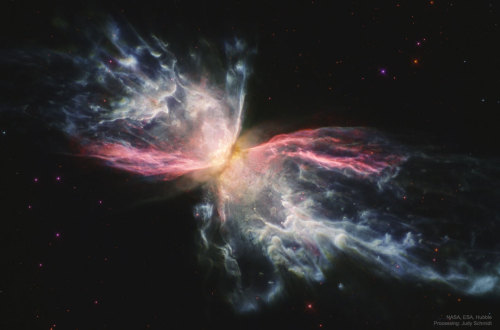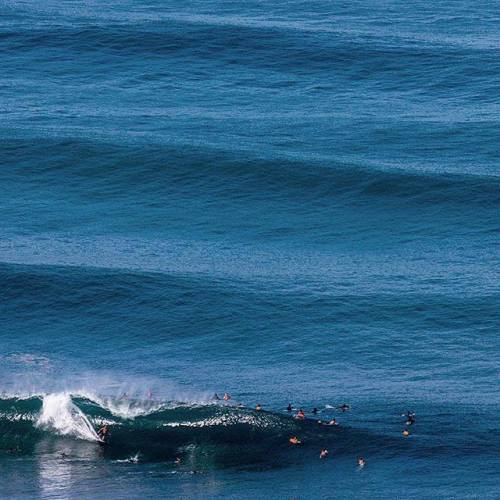
janerunner
I’m just me
38 posts
Latest Posts by janerunner

Stars and Planets over Portugal : The mission was to document night-flying birds – but it ended up also documenting a beautiful sky. The featured wide-angle mosaic was taken over the steppe golden fields in Mértola, Portugal in 2020. From such a dark location, an immediately-evident breathtaking glow arched over the night sky: the central band of our Milky Way galaxy. But this sky had much more. Thin clouds crossed the sky like golden ribbons. The planet Mars appeared on the far left, while the planets Saturn and Jupiter were also simultaneously visible – but on the opposite side of the sky, here seen on the far right. Near the top of the image the bright star Vega can be found, while the far-distant and faint Andromeda Galaxy can be seen toward the left, just below Milky Way’s arch. As the current month progresses, several planets are lining up in the pre-dawn sky: Jupiter, Venus, Mars, and Saturn. via NASA
Summer Starts in the Northern Hemisphere!
Today is the first day of summer in the Northern Hemisphere -- the solstice! People located in the Northern Hemisphere will have the longest day of the year today, and people located in the Southern Hemisphere will have the shortest day of the year.

The angle between the Earth’s orbit and the axis of its rotation creates our seasons, tilting each hemisphere toward the Sun during summer in that half of the Earth. This is summer in the Northern Hemisphere, and winter in the Southern Hemisphere. The other half of the year, the Northern Hemisphere is tilted away from the Sun, creating winter in the north and summer in the south.

Solstices happen twice per year, at the points in Earth’s orbit where this tilt is most pronounced.

These days are the longest (in the summer hemisphere) and shortest (in the winter hemisphere) of the year, and mark the change of seasons to summer and winter, respectively.
For more Earth science, follow NASA Earth on Twitter, on Facebook, or on the web.
Make sure to follow us on Tumblr for your regular dose of space!
Bluebird raising a family from day 1 to finish | source
The massive doors of Saint John Lateran are over 2,000 years old. They are perfectly balanced, taking only one person to open and close them.
Source

when your nurse colleague gets you
#BestGiftsForNurses
💀😄

Summer Starts in the Northern Hemisphere!
Today is the first day of summer in the Northern Hemisphere -- the solstice! People located in the Northern Hemisphere will have the longest day of the year today, and people located in the Southern Hemisphere will have the shortest day of the year.

The angle between the Earth’s orbit and the axis of its rotation creates our seasons, tilting each hemisphere toward the Sun during summer in that half of the Earth. This is summer in the Northern Hemisphere, and winter in the Southern Hemisphere. The other half of the year, the Northern Hemisphere is tilted away from the Sun, creating winter in the north and summer in the south.

Solstices happen twice per year, at the points in Earth’s orbit where this tilt is most pronounced.

These days are the longest (in the summer hemisphere) and shortest (in the winter hemisphere) of the year, and mark the change of seasons to summer and winter, respectively.
For more Earth science, follow NASA Earth on Twitter, on Facebook, or on the web.
Make sure to follow us on Tumblr for your regular dose of space!

Happy Summer Solstice 🤍🌞

President Kennedy Awards Alan Shepard NASA’s Distinguished Service Medal via NASA https://ift.tt/3toduXY
Peaceful



Sleeping on clouds

daSunrise




Waves vibes


Iron in the Butterfly Nebula : Can stars, like caterpillars, transform themselves into butterflies? No, but in the case of the Butterfly Nebula – it sure looks like it. Though its wingspan covers over 3 light-years and its estimated surface temperature exceeds 200,000 degrees, C, the dying central star of NGC 6302, the featured planetary nebula, has become exceptionally hot, shining brightly in visible and ultraviolet light but hidden from direct view by a dense torus of dust. This sharp close-up was recorded by the Hubble Space Telescope and is reprocessed here to show off the remarkable details of the complex planetary nebula, highlighting in particular light emitted by iron, shown in red. NGC 6302 lies about 4,000 light-years away in the arachnologically correct constellation of the Scorpion (Scorpius). Planetary nebulas evolve from outer atmospheres of stars like our Sun, but usually fade in about 20,000 years. via NASA



“I found I could say things with colour and shapes that I couldn’t say any other way… things I had no words for.” -Georgia O'Keeffe-

Georgia O'Keeffe


Rotating Moon from LRO : No one, presently, sees the Moon rotate like this. That’s because the Earth’s moon is tidally locked to the Earth, showing us only one side. Given modern digital technology, however, combined with many detailed images returned by the Lunar Reconnaissance Orbiter (LRO), a high resolution virtual Moon rotation movie has been composed. The featured time-lapse video starts with the standard Earth view of the Moon. Quickly, though, Mare Orientale, a large crater with a dark center that is difficult to see from the Earth, rotates into view just below the equator. From an entire lunar month condensed into 24 seconds, the video clearly shows that the Earth side of the Moon contains an abundance of dark lunar maria, while the lunar far side is dominated by bright lunar highlands. Currently, over 19 new missions to the Moon are under active development from eight different countries, most of which have expected launch dates in the next three years. via NASA

6’0” x 18 3/4” x 2 5/16” for @liamjolly, the latest version of the Jollypop.. #okesurfboards (at Oke Surfboards) https://www.instagram.com/p/CO16R7aMeX4/?igshid=mw8yc930wnnj

Pipe… lines







Kerhonkson, New York
Black Holes: Seeing the Invisible!
Black holes are some of the most bizarre and fascinating objects in the cosmos. Astronomers want to study lots of them, but there’s one big problem – black holes are invisible! Since they don’t emit any light, it’s pretty tough to find them lurking in the inky void of space. Fortunately there are a few different ways we can “see” black holes indirectly by watching how they affect their surroundings.

Speedy stars
If you’ve spent some time stargazing, you know what a calm, peaceful place our universe can be. But did you know that a monster is hiding right in the heart of our Milky Way galaxy? Astronomers noticed stars zipping superfast around something we can’t see at the center of the galaxy, about 10 million miles per hour! The stars must be circling a supermassive black hole. No other object would have strong enough gravity to keep them from flying off into space.

Two astrophysicists won half of the Nobel Prize in Physics last year for revealing this dark secret. The black hole is truly monstrous, weighing about four million times as much as our Sun! And it seems our home galaxy is no exception – our Hubble Space Telescope has revealed that the hubs of most galaxies contain supermassive black holes.
Shadowy silhouettes
Technology has advanced enough that we’ve been able to spot one of these supermassive black holes in a nearby galaxy. In 2019, astronomers took the first-ever picture of a black hole in a galaxy called M87, which is about 55 million light-years away. They used an international network of radio telescopes called the Event Horizon Telescope.

In the image, we can see some light from hot gas surrounding a dark shape. While we still can’t see the black hole itself, we can see the “shadow” it casts on the bright backdrop.
Shattered stars
Black holes can come in a smaller variety, too. When a massive star runs out of the fuel it uses to shine, it collapses in on itself. These lightweight or “stellar-mass” black holes are only about 5-20 times as massive as the Sun. They’re scattered throughout the galaxy in the same places where we find stars, since that’s how they began their lives. Some of them started out with a companion star, and so far that’s been our best clue to find them.

Some black holes steal material from their companion star. As the material falls onto the black hole, it gets superhot and lights up in X-rays. The first confirmed black hole astronomers discovered, called Cygnus X-1, was found this way.
If a star comes too close to a supermassive black hole, the effect is even more dramatic! Instead of just siphoning material from the star like a smaller black hole would do, a supermassive black hole will completely tear the star apart into a stream of gas. This is called a tidal disruption event.
Making waves
But what if two companion stars both turn into black holes? They may eventually collide with each other to form a larger black hole, sending ripples through space-time – the fabric of the cosmos!

These ripples, called gravitational waves, travel across space at the speed of light. The waves that reach us are extremely weak because space-time is really stiff.
Three scientists received the 2017 Nobel Prize in Physics for using LIGO to observe gravitational waves that were sent out from colliding stellar-mass black holes. Though gravitational waves are hard to detect, they offer a way to find black holes without having to see any light.
We’re teaming up with the European Space Agency for a mission called LISA, which stands for Laser Interferometer Space Antenna. When it launches in the 2030s, it will detect gravitational waves from merging supermassive black holes – a likely sign of colliding galaxies!

Rogue black holes
So we have a few ways to find black holes by seeing stuff that’s close to them. But astronomers think there could be 100 million black holes roaming the galaxy solo. Fortunately, our Nancy Grace Roman Space Telescope will provide a way to “see” these isolated black holes, too.

Roman will find solitary black holes when they pass in front of more distant stars from our vantage point. The black hole’s gravity will warp the starlight in ways that reveal its presence. In some cases we can figure out a black hole’s mass and distance this way, and even estimate how fast it’s moving through the galaxy.
For more about black holes, check out these Tumblr posts!
⚫ Gobble Up These Black (Hole) Friday Deals!
⚫ Hubble’s 5 Weirdest Black Hole Discoveries
Make sure to follow us on Tumblr for your regular dose of space: http://nasa.tumblr.com.
Meet Megan McArthur, NASA Astronaut & Crew-2 Pilot
NASA astronaut Megan McArthur will launch on Friday, April 23 to the International Space Station as the pilot for NASA’s SpaceX Crew-2 mission! This is the second crew rotation flight with astronauts on the Crew Dragon spacecraft and the first launch with two international partners as part of the agency’s Commercial Crew Program. McArthur is responsible for spacecraft systems and performance and is assigned to be a long-duration space station crew member. While this is her first trip to the space station, McArthur’s career has prepared her well for this important role on the Crew-2 team!

McArthur on the Crew Access Arm of the mobile launcher inside the Vehicle Assembly Building at Kennedy Space Center. Credits: NASA/Joel Kowsky
McArthur was born in Honolulu, Hawaii and grew up in California. She is a former Girl Scout and has a Bachelor of Science in Aerospace Engineering from the University of California, Los Angeles and a Ph.D. in Oceanography from the University of California, San Diego where she performed research activities at the Scripps Institution of Oceanography.

McArthur floating in microgravity during her STS-125 mission in 2009 aboard space shuttle Atlantis. Credits: NASA
While in graduate school, McArthur conducted research, served as Chief Scientist for at-sea data collection operations, and planned and led diving operations. She also volunteered at the Birch Aquarium at Scripps, conducting educational demonstrations for the public from inside a 70,000-gallon exhibit tank of the California Kelp Forest. Her experience conducting research in extreme conditions will certainly come in handy once she’s aboard the space station, as a big part of the astronauts’ job involves running research experiments in microgravity.

McArthur, seen through the window of space shuttle Atlantis, operating the robotic arm during a spacewalk. Credits: NASA
McArthur was selected as a NASA astronaut in 2000 and flew her first spaceflight aboard STS-125, the final space shuttle mission to service the Hubble Space Telescope. She worked as the flight engineer during launch and landing, and also served as the shuttle's robotic arm operator as she carefully retrieved the telescope and placed it in the shuttle’s cargo bay for servicing. The successful mission improved the telescope's capabilities and extended its life – and Hubble is still helping us make discoveries about our universe.

McArthur pictured in her pressure suit during a training session at SpaceX HQ in Hawthorne, California. Credits: NASA
Now, it’s time for the next big milestone in McArthur’s career! On Friday, April 23 Crew-2 will launch from Kennedy Space Center in Florida en route to the International Space Station. McArthur is the pilot of the Crew Dragon spacecraft and second-in-command for the mission.
NASA TV coverage of Crew-2 launch preparations and liftoff will begin at 1:30 a.m. EDT Friday, April 23 with launch scheduled for 5:49 a.m. EDT. Crew Dragon is scheduled to dock to the space station Saturday, April 24, at approximately 5:10 a.m. EDT. Watch live: www.nasa.gov/nasalive
Make sure to follow us on Tumblr for your regular dose of space: http://nasa.tumblr.com

This otter-ball is dedicated to @hubbird. Thanks for the shout-out yesterday and hello to all my new otter-loving friends!

smug little guys.